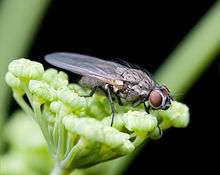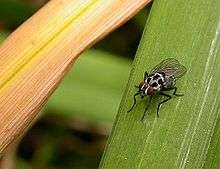Anthomyiidae
The Anthomyiidae are a large and diverse family of Muscoidea flies. Most look rather like small houseflies, but are commonly drab grey. The genus Anthomyia, in contrast, is generally conspicuously patterned in black-and-white or black-and-silvery-grey. Most are difficult to identify, apart from a few groups such as the kelp flies that are conspicuous on beaches.
| Anthomyiidae | |
|---|---|
.jpg) | |
| Root-maggot fly Hydrophoria linogrisea | |
| Scientific classification | |
| Kingdom: | Animalia |
| Phylum: | Arthropoda |
| Class: | Insecta |
| Order: | Diptera |
| (unranked): | Eremoneura |
| (unranked): | Cyclorrhapha |
| Section: | Schizophora |
| Subsection: | Calyptratae |
| Superfamily: | Muscoidea |
| Family: | Anthomyiidae Robineau-Desvoidy, 1830 |
| Subfamilies | |
| |
The name Anthomyiidae was derived from Greek anthos (flower) plus myia (a fly). Some species are commonly called "root-maggots", as the larvae are found in the stems and roots of various plants. As larvae, some also feed on decaying plant material. The well-known grey "seaweed flies" or "kelp flies" (Fucellia) are examples.[1] Others are scavengers in such places as birds' nests; yet other species are leaf miners; the family also includes inquilines, commensals, and parasitic larvae.
Some species in the family are significant agricultural pests, particularly some from the genus Delia, which includes the onion fly (D. antiqua), the wheat bulb fly (D. coarctata), the turnip root fly (D. floralis), the bean seed fly (D. platura), and the cabbage root fly (D. radicum).
Description
For terms see Morphology of Diptera
These flies are small or moderate in size. Hypopleural bristles found on the sides of the thorax are apical. The anal vein of the wing reaches the margin of the wings (except in Chelisia). The median vein is straight, not curved towards the anterior alar margin. Three pairs of postsutural dorsocentral bristles almost always are present. The first segment of the posterior tarsi are on the lower side near the base with minute bristles. The sternopleuron lower side often has short, soft hairs. Eyes in the male in most cases are close-set or contiguous. Females of many species are not known as of yet.
Classification
- Family Anthomyiidae -- anthomyiid flies
- Subfamily Anthomyiinae
- Tribe Anthomyiini
- Genus Anthomyia Meigen, 1803
- Genus Botanophila Lioy, 1864
- Genus Chiastocheta Pokorny, 1889
- Genus Fucellia Robineau-Desvoidy, 1842
- Genus Hylemya Robineau-Desvoidy, 1830
- Genus Hylemyza Schnabl & Dziedzicki, 1911
- Tribe Chirosiini
- Tribe Hydrophoriini
- Genus Acridomyia Stackelberg, 1929
- Genus Adia Robineau-Desvoidy, 1830
- Genus Boreophorbia Michelsen, 1987
- Genus Coenosopsia Malloch, 1924
- Genus Delia Robineau-Desvoidy, 1830
- Genus Eustalomyia Kowarz, 1873
- Genus Heterostylodes Hennig, 1967
- Genus Hydrophoria Robineau-Desvoidy, 1830
- Genus Leucophora Robineau-Desvoidy, 1830
- Genus Paregle Schnabl, 1911
- Genus Phorbia Robineau-Desvoidy, 1830
- Genus Subhylemyia Ringdahl, 1933
- Genus Zaphne Robineau-Desvoidy, 1830
- Subfamily Pegomyinae
- Tribe Pegomyini
- Genus Alliopsis Schnabl & Dziedzicki, 1911
- Genus Emmesomyia Malloch, 1917
- Genus Eutrichota Kowarz, 1893
- Genus Mycophaga Rondani, 1856
- Genus Paradelia Ringdahl, 1933
- Genus Parapegomyia Griffiths, 1984
- Genus Pegomya Robineau-Desvoidy, 1830
- Tribe Myopinini
- Genus Pegoplata Schnabl & Dziedzicki, 1911
- Genus Calythea Schnabl in Schnabl & Dziedzicki, 1911
- Genus Myopina Robineau-Desvoidy, 1830
See also
References
- Alan Weaving; Mike Picker; Griffiths, Charles Llewellyn (2003). Field Guide to Insects of South Africa. New Holland Publishers, Ltd. ISBN 1-86872-713-0.
Further reading
- Genera - Suwa, M., & B. Darvas, 1998. Family Anthomyiidae. In: Contributions to a manual of Palaearctic Diptera Volume 3 (L. Papp & B. Darvas, eds.): 571–616. Science Herald, Budapest.
- Species - Hennig, W., 1966–1976. 63a. Anthomyiidae. In: Die Fliegen der paläarktischen Region 7(1) (Erwin Lindner, ed.): 1–974, pl. 1-78. E. Schweizerbart, Stuttgart.
Identification
- Ackland, D. M. 2001. Revision of afrotropical Anthomyia Meigen, 1803 (Diptera: Anthomyiidae), with descriptions of ten new species. African Invertebrates 42: 1-94.
- Ackland, D. M. 2008. Revision of Afrotropical Delia Robineau-Desvoidy, 1830 (Diptera: Anthomyiidae), with descriptions of six new species. African Invertebrates 49 (1): 1-75.
- K. Yu. Elberg Family Anthomyiidae in Bei-Bienko, G. Ya, 1988 Keys to the insects of the European Part of the USSR Volume 5 (Diptera) Part 2 English edition
- Emden, F. I. Van (1941): Keys to the Muscidae of the Ethiopian Region :Scatophaginae, Anthomyiinae, Lispinae, Fanniinae. Bull. Ent.Res., 1941–1942, 32: 251–275. Keys to Afrotropical genera and species. See Pont & Ackland in Crosskey, R. W. et al. 1980 for updated classification and nomenclature.
- Hennig, W., 1966–1976. 63a. Anthomyiidae. In: Die Fliegen der paläarktischen Region 7(1) (Erwin Lindner, ed.): 1–974, pl. 1-78. E. Schweizerbart, Stuttgart. Monograph of Palaearctic species.
- Hucket, H. C. (1965): The Muscidae of Northern Canada, Alaska and Greenland (Diptera). Mem. Ent. Soc. Canada, 42: 1–369. Keys, illustrations.
- Huckett H. C. (1971): The Anthomyiidae of California exclusive of. the subfamily Scatophaginae (Diptera). Bull. Calif. Insect Survey. 12: 1–121. Illustrated Keys. South Nearctic and North Neotropical.
- Pont, A.C., 1972, Family Muscidae. In: A Catalogue of the Diptera of the Americas South of the United States, 97, 111 p. Museu de Zoologia, Universidade de São Paulo, São Paulo.
- Suwa, M. (1974): Anthomyiidae of Japan (Diptera). Insecta Matsumurana New Series 4 : 1–247. Comprehensive revision. Excellent illustrations.
- Suwa, M., & B. Darvas (1998): Family Anthomyiidae. In: Contributions to a manual of Palaearctic Diptera Volume 3 (L. Papp & B. Darvas, eds.): 571–616. Science Herald, Budapest.
Species lists
External links
| Wikimedia Commons has media related to Anthomyiidae. |
| Wikispecies has information related to Anthomyiidae |

